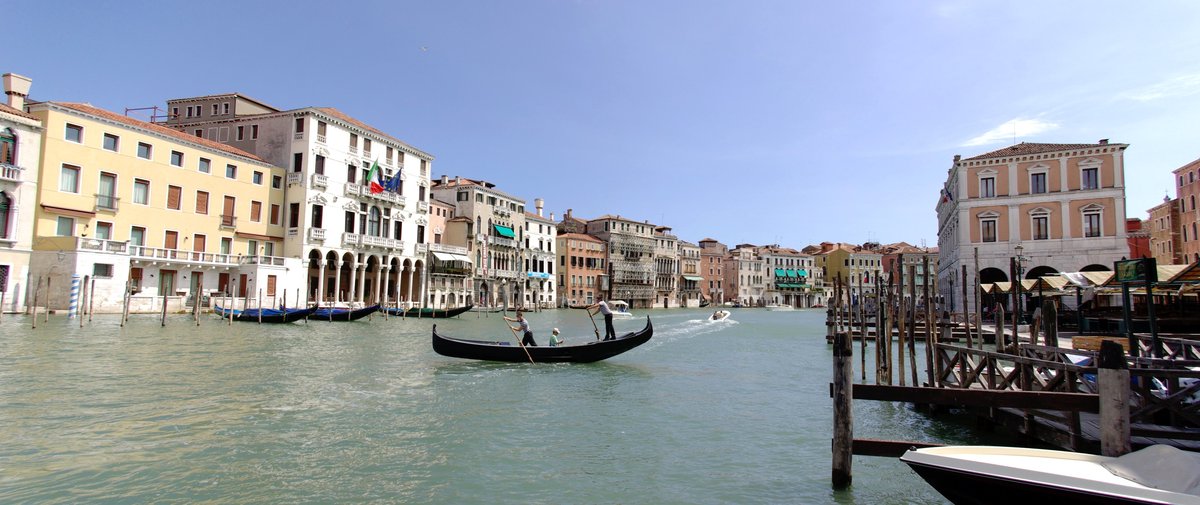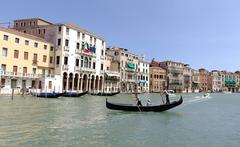
Palazzo Michiel Dalle Colonne Venice: Visiting Hours, Tickets, and Historical Site Guide
Date: 15/06/2025
Introduction
Palazzo Michiel Dalle Colonne, a striking example of Venetian palatial architecture, stands proudly along the Grand Canal in the Cannaregio district. With origins reaching back to the 13th century and later Baroque transformations, the palace embodies the layered narrative of Venice’s patrician society, architectural evolution, and ongoing cultural vitality. Today, it serves both as a monument to Venice’s illustrious past and a dynamic venue for contemporary art, international forums, and events—particularly during the Venice Biennale. This comprehensive guide provides essential visitor information, practical travel tips, and in-depth historical context for those seeking to explore one of Venice’s most emblematic historical sites. (Wikipedia, Italyscapes, La Biennale di Venezia)
Contents
- Location and Setting
- Visiting Information
- Opening Hours & Tickets
- Entry Requirements
- Accessibility & Travel Tips
- Architectural and Historical Overview
- Origins and Early History
- Baroque Transformation
- Notable Architectural Features
- Interior Highlights
- Noteworthy Residents and Events
- Cultural Role and Contemporary Use
- Frequently Asked Questions (FAQ)
- Visual Gallery
- Conclusion and Visitor Tips
- Sources
Location and Setting
Palazzo Michiel Dalle Colonne is ideally situated on the northern bank of Venice’s Grand Canal in the Cannaregio sestiere, just south of the intersection with Rio dei Santi Apostoli. Its address, Cannaregio 4391, places it adjacent to Palazzo Michiel del Brusà and across from the vibrant Rialto Market. The palace is approximately 250 meters from the iconic Rialto Bridge, ensuring both centrality and scenic grandeur. Visitors can easily reach the site via vaporetto (waterbus) stops at Ca’ d’Oro or Rialto, or enjoy a short walk through the atmospheric Cannaregio neighborhood. (Italyscapes, Wikipedia)
Visiting Information
Opening Hours & Tickets
- General Schedule: Open to the public during major events (notably the Venice Biennale) and special exhibitions, typically from 10:00 AM to 6:00 PM, Tuesday through Sunday. Closed on Mondays and select holidays.
- Tickets: Most exhibitions are free; however, special events or guided tours may require tickets or advance reservations. Tickets (when required) can be purchased via the European Cultural Centre (ECC) website or at the entrance.
- Guided Tours: Offered in multiple languages (English, Italian, French, Spanish), with advance booking recommended during peak seasons and for special events.
Entry Requirements
- Valid identification may be required for discounted tickets or certain events.
- Photography is permitted without flash; however, some rooms may have restrictions to protect artworks and decorations.
Accessibility & Travel Tips
- Accessibility: While the palace has modern amenities, some areas remain challenging for visitors with limited mobility due to the historic structure. Contact the ECC in advance to discuss accommodations.
- Getting There: Vaporetto stops at Ca’ d’Oro and Rialto offer convenient access. The palace is also within easy walking distance from Santa Lucia railway station.
- Facilities: Restrooms and a reception area are available; there is no on-site café, but nearby Cannaregio offers many local dining options.
- Best Times to Visit: Early mornings or late afternoons on weekdays are recommended to avoid crowds, especially during the Biennale.
Architectural and Historical Overview
Origins and Early History
Constructed in the 13th century, Palazzo Michiel Dalle Colonne was commissioned by the influential Grimani family, as evidenced by the Grimani coat of arms found on the courtyard well. The original structure reflected the Venetian-Byzantine architectural style, featuring a compact, rectangular plan, three stories, and a prominent ground-floor loggia with seven arches supported by marble columns—hence the name “dalle Colonne” (“of the Columns”). (Conoscere Venezia)
Baroque Transformation
A significant transformation took place in the late 17th century under the Zen dalle Colonne family, who commissioned architect Antonio Gaspari to redesign the palace. Gaspari’s 1697 intervention introduced Baroque symmetry and grandeur, adding two noble floors with serliana (Palladian) windows and embellishing the façade with broken tympanums and sculpted busts. The iconic ground-floor portico, with its imposing columns, was preserved and remains a rare feature among Venetian palaces. (Italyscapes)
Notable Architectural Features
- Portico and Columns: The continuous arcaded ground floor is lined with tall, robust columns—among the tallest on the Grand Canal—serving both structural and decorative functions.
- Façade Symmetry: The Baroque façade exhibits harmonious alignment, with two noble floors over the portico, each featuring central serliana windows flanked by single-lancet windows, all capped with broken tympanums and decorative busts.
- Attic Level: The attic contains six smaller windows with balustrades, maintaining the building’s overall symmetry.
- Interior Stuccoes and Frescoes: 18th-century stuccoes attributed to Michelangelo Morlaiter and allegorical frescoes adorn the palace’s main halls, depicting themes such as Victory, Merit, Abundance, and Peace. (VisitVenezia)
Interior Highlights
- Stuccoes by Morlaiter: Delicate Rococo stucco work, especially on the piano nobile, showcases the refinement of Venetian decorative arts.
- Allegorical Paintings: The palace features allegorical frescoes reminiscent of the work of Tiepolo and Guarana, enriching the visitor experience.
- Courtyard Well: The original well, engraved with the Grimani coat of arms, offers a tangible link to the palace’s early history.
- Grand Canal Views: Large windows on the upper floors provide sweeping vistas of the Grand Canal and Venetian life.
Noteworthy Residents and Events
Palazzo Michiel Dalle Colonne has hosted significant historical figures, including exiled nobility such as Ferdinando Carlo di Gonzaga-Nevers, and has welcomed European royals during major Venetian festivities. The palace later became the residence of the Michiel family—one of Venice’s most distinguished patrician lineages—and was known for hosting high-profile events and cultural gatherings. In the 20th century, the building underwent various uses, including as political headquarters and, post-restoration, as a protected public asset. (Wikipedia)
Cultural Role and Contemporary Use
Today, Palazzo Michiel Dalle Colonne is a vibrant center for contemporary art and cultural exchange. Managed by the European Cultural Centre, the palace hosts major exhibitions, international forums (such as “Shaping the City”), and collateral events for the Venice Biennale. Its adaptable interiors allow for a range of cultural programming, ensuring its continued relevance as both a historical monument and a living institution within Venice’s cultural landscape. (La Biennale di Venezia, Shaping the City Forum)
Frequently Asked Questions (FAQ)
Q: What are the visiting hours of Palazzo Michiel Dalle Colonne?
A: The palace is generally open 10:00 AM to 6:00 PM during major events and exhibitions, but not regularly year-round. Check the ECC website for current schedules.
Q: Do I need a ticket to visit?
A: Most exhibitions are free; guided tours or special events may require tickets or reservations.
Q: Is the palace wheelchair accessible?
A: Some areas are accessible, but due to the historic structure, there are limitations. Contact the venue in advance for assistance.
Q: Are guided tours available?
A: Yes, guided tours are offered during exhibition periods, usually in multiple languages.
Q: Can I take photos inside?
A: Photography is typically allowed without flash or tripods.
Q: How do I get there by public transport?
A: The nearest vaporetto stops are Ca’ d’Oro and Rialto. The palace is also within walking distance from Santa Lucia station.
Visual Gallery
- Palazzo Michiel Dalle Colonne: Baroque façade viewed from the Rialto Market across the Grand Canal
(alt text: “Palazzo Michiel Dalle Colonne Baroque facade viewed from Rialto Market, Venice”) - Detail of the arcaded water floor and portico columns
(alt text: “Tall columns of Palazzo Michiel Dalle Colonne portico in Venice”) - 18th-century stucco decorations by Michelangelo Morlaiter
(alt text: “Stucco decorations inside Palazzo Michiel Dalle Colonne, Venice”)
Conclusion and Visitor Tips
Palazzo Michiel Dalle Colonne is a must-visit for those seeking to immerse themselves in Venice’s living heritage. Its architectural splendor, layered history—from Venetian-Byzantine roots to Baroque magnificence—and contemporary cultural programming offer a multifaceted visitor experience. For the best experience, check current opening hours and event schedules on the ECC website, plan your visit during major exhibitions or the Venice Biennale, and consider booking a guided tour for deeper insight.
Enhance your Venice itinerary by exploring nearby historical sites such as Ca’ d’Oro, Palazzo Grimani, and the lively Rialto Market. For up-to-date travel guides, event news, and ticketing information, download the Audiala app and follow trusted cultural platforms.
Sources and Further Reading
- Wikipedia
- Italyscapes
- La Biennale di Venezia
- European Cultural Centre
- Conoscere Venezia
- Venice Architecture - Palaces
- Shaping the City Forum













































































































